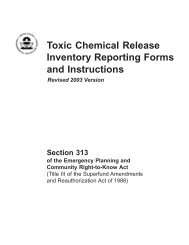Ergonomic Guidelines for Nursing Homes - Seton Resource Center
Ergonomic Guidelines for Nursing Homes - Seton Resource Center
Ergonomic Guidelines for Nursing Homes - Seton Resource Center
Create successful ePaper yourself
Turn your PDF publications into a flip-book with our unique Google optimized e-Paper software.
Lateral Transfer; Repositioning<br />
Description: Devices to reduce friction <strong>for</strong>ce when transferring a resident<br />
such as a draw sheet or transfer cot with handles to be used in combination<br />
slippery sheets, low friction mattress covers, or slide boards; boards or mats<br />
with vinyl coverings and rollers; gurneys with transfer devices; and air-assist<br />
lateral sliding aid or flexible mattress inflated by portable air supply.<br />
When To Use: Transferring a partial- or non-weight bearing resident between 2 horizontal surfaces such as a bed to a stretcher or<br />
gurney while lying on their back or when repositioning resident in bed.<br />
Points to Remember: More than one caregiver is needed to per<strong>for</strong>m this type of transfer or repositioning. Additional assistance may<br />
be needed depending upon resident status, e.g., <strong>for</strong> heavier or non-cooperative residents. Some devices may not be suitable <strong>for</strong><br />
bariatric residents. When using a draw sheet combination use a good hand-hold by rolling up draw sheets or use other friction-reducing<br />
devices with handles such as slippery sheets. Narrower slippery sheets with webbing handles positioned on the long edge of the sheet<br />
may be easier to use than wider sheets. When using boards or mats with vinyl coverings and rollers use a gentle push and pull motion<br />
to move resident to new surface.<br />
Look <strong>for</strong> a combination of devices that will increase resident’s com<strong>for</strong>t and minimize risk of skin trauma. Ensure transfer surfaces are at<br />
same level and at a height that allows caregivers to work at waist level to avoid extended reaches and bending of the back. Count<br />
down and synchronize the transfer motion between caregivers.<br />
Lateral Transfer;<br />
Repositioning<br />
Description: Convertible<br />
wheelchair, Geri or cardiac<br />
chair to bed; beds that<br />
convert to chairs.<br />
Repositioning<br />
in Chair<br />
Description: Variable<br />
position Geri and Cardiac<br />
chairs<br />
When to Use: For lateral transfer of residents who are partial- or<br />
non-weight bearing. Eliminates the need to per<strong>for</strong>m lift transfer in<br />
and out of wheelchairs. Can also be used to assist residents who<br />
are partially weight bearing from a sit-to-stand position. Beds that<br />
convert to chairs can aid repositioning residents who are totally<br />
dependent, non-weight bearing, very heavy, or have other physical<br />
limitations.<br />
Points to Remember: More than one caregiver is needed to<br />
per<strong>for</strong>m lateral transfer. Additional assistance <strong>for</strong> lateral transfer<br />
may be needed depending on residents status, e.g., <strong>for</strong> heavier or<br />
non-cooperative residents. Additional friction-reducing devices<br />
may be required to reposition resident. Heavy duty beds are<br />
available <strong>for</strong> bariatric residents. Device should have easy-to-use<br />
controls located within easy reach of the caregiver, sufficient foot<br />
clearance, and wide range of adjustment. Motorized heightadjustable<br />
devices are preferred to those adjusted by crank<br />
mechanism to minimize physical exertion. Always ensure device<br />
is in good working order be<strong>for</strong>e use. Ensure wheels on equipment<br />
are locked. Ensure transfer surfaces are at same level and at a<br />
height that allows caregivers to work at waist level to avoid<br />
extended reaches and bending of the back.<br />
When to Use: Repositioning partial- or non-weight-bearing<br />
residents who are cooperative.<br />
Points to Remember: More than one caregiver is needed and use<br />
of a friction-reducing device is needed if resident cannot assist to<br />
reposition self in chair. Ensure use of good body mechanics by<br />
caregivers. Wheels on chair add versatility. Ensure that chair is<br />
easy to adjust, move, and steer. Lock wheels on chair be<strong>for</strong>e<br />
repositioning. Remove trays, footrests, and seat belts where<br />
appropriate. Ensure device is rated <strong>for</strong> the resident weight.

















